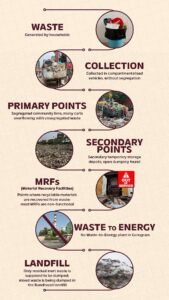Gurugram – Gurugram claim of processing a remarkable 98 percent of its daily waste has been exposed as a “statistical illusion,” according to on-the-ground investigations that reveal a system in complete disarray despite an annual expenditure of ₹45 crore. The city, which generates approximately 1,200 tonnes of waste every day, manages little more than relocating garbage until it becomes a hazard for the Aravalli forests and nearby communities, experts warn.

The Municipal Corporation of Gurugram’s (MCG) boast of a leap from 140th to 41st in the 2024–25 Swachh Survekshan rankings is directly contradicted by official figures showing a collapse in fundamental sanitation metrics. The rate of door-to-door collection dropped from 98 percent to 59 percent over three years, while source segregation plunged from 97 percent to a mere 10 percent. This data suggests that the high processing rate is not an operational reality but an inaccurate reflection of a system where nearly half the waste never enters the formal channel.
A Breakdown at Every Operational Stage
The investigation found that the entire waste management process, mandated by the national Solid Waste Management Rules 2016, is defunct, leading to a rising number of unauthorized garbage dumps across the city.
The system is broken at the first step: segregation. Rules require waste to be sorted into wet, dry, and hazardous categories at the household level, but this is rarely followed. Mixed waste a blend of food scraps, plastics, medical waste, and construction debris is the norm. This failure begins at the top, with a local councillor even claiming the MCG directed them to collect the mixed waste as it is.
The Second Mile: Defunct Secondary Collection Points
Waste moves from homes to Secondary Collection Points (SCPs), which are meant to be logistical bridges for aggregation and segregation. The MCG lists 14 such sites, but nearly all visited were found to be operating in violation of norms, serving instead as open dumping grounds. Sites in Kanhai, Tulip Chowk, and Daulatabad were observed to be chaotic dumps of unsegregated garbage, with no segregation pits or machinery.
Furthermore, most sites that the Haryana State Pollution Control Board (HSPCB) delisted were found to be still functioning as illegal open dumps. The environmental impact is immediate, with farmers near the Daulatabad point claiming that the pollution and waste particles affect their crops.
The Third Mile: Ghost Recovery Facilities
The crucial Material Recovery Facilities (MRFs), designed to sort, process, and reduce waste load, exist primarily on paper. The MCG claims five facilities are in operation. However, four of these sites were visited and found to be either locked, defunct, or serving as open dumps. The Beriwala Bagh site, which was supposed to be Gurugram’s largest processing facility, now functions as an open dump where mixed garbage seeps onto the roads after rain, fully exposing the gap between official claims and ground reality.

Ultimately, public health experts warn that Gurugram’s waste strategy is one of relocation, merely shifting the problem until the environment the Aravalli forests and its proximity to the Bandhwari landfill is forced to bear the cost.
